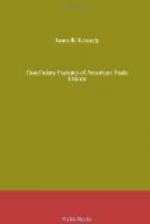[Footnote 115: American Federationist, Vol. 2, No. 4, p. 61.]
[Footnote 116: The Carpenter, Vol. 4, August, 1884.]
[Footnote 117: The Painter, Vol. 1, April, 1887; Vol. 17, p. 529.]
[Footnote 118: Constitution of the Cigar Makers’ International Union of America, 1887 (Buffalo, 1888), Art. 10.]
The wife’s death benefit is designed to defray the cost of burial. It is, therefore, small in amount, not exceeding fifty dollars in any of the unions in which it is important. The following table gives the minimum amounts of the wife’s funeral benefit paid under the original and under the present rules in the five unions in which the benefit is of importance. The term of membership required for participation in the benefit is also shown.
Minimum amount of
wife’s death benefit.
============================================================
=========
| Originally. | In
1905.
|------------------------------------------------------
Name of Union.|Amount.|Required Period of| Amount.|Required
Period of
| | Membership. |
| Membership.
------------------------------------------------------------
---------
Bakers........| $50 | 6 mo. | $50 |
6 mo. Carpenters....| 50 | 6 mo.
| 25 | 6 mo. Cigar Makers..|
40 | 2 yr. | 40 | 2 yr.
Painters......| 25 | 6 mo. | 50 |
1 yr. Typographia...| 25 | 1 yr.
| 50 | none ---------------------------------
------------------------------------
The wife’s death benefit is not graded except in the case of the Carpenters, where the minimum benefit is twenty-five dollars for six months’ and fifty dollars for one year’s membership. The minimum given in the above table is in all other cases also the maximum.
The success of the wife’s death or funeral benefit is not beyond controversy. The Tailors, who began to pay the benefit in 1889, abandoned it in 1898. The benefit was at first seventy-five dollars after three months’ membership, but it was remodelled until in 1896 it became a graded benefit ranging from twenty-five dollars to fifty dollars according to the length of membership. The chief objection to the benefit was that unmarried members were taxed to support the benefit although they did not participate in the advantages. In 1898 Secretary Lennon declared that the benefit “was based on real injustice, giving one member more benefits for the same dues paid than to another."[119] In other unions which maintain the benefit this objection has been met to some extent, as in the Cigar Makers, by paying the benefit on the death of the widowed mother of an unmarried member provided she was solely dependent upon him for support. Provision is usually made that no member shall receive the wife’s funeral benefit more than once. This rule is intended partly to prevent fraud but chiefly to meet the complaint that the benefit confers unequal advantages.




